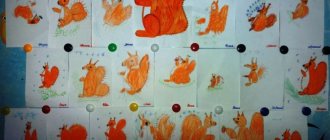MAGAZINE Preschooler.RF
Summary of a lesson on social and moral education in the preparatory group “Boys and Girls”Nakhodka MBDOU TsRR d/s No. 5 “Dolphin” in-l: Salivonchik L.A.
Goal: To form an idea of the differences between boys and girls - both external and in character traits and behavior. To form the prerequisites for masculinity and femininity, which manifest themselves in relation to representatives of the opposite sex. Form an emotionally positive attitude towards fulfilling a future social role. To develop the ability to use elements of speech-evidence. Foster a culture of communication with partners of the opposite sex in various situations and gaming activities.
Activation of vocabulary: charming, broad-shouldered, elegant, graceful, charming, pretty, young man, muscular, tall, etc.
Preliminary work: Reading a fairy tale and watching the cartoon “The Sleeping Beauty” by Ch. Perrault, memorizing the poems “Boys and Girls” , “All the girls are laughing…” , “All the boys are naughty…” , making fashion magazines for girls and boys (consolidating men’s and women’s clothes), organizing a photo exhibition of children's photographs, questioning parents on the topic: “Socio-moral education of preschool children ,” conversations on the topic of moral education, didactic games, learning songs about friendship, learning a pair dance, etc.
Equipment: pads for each child, next to the pad there is an attribute for a girl or boy (hairpin, car, doll, etc.), attributes for a game to remember the age sequence (wigs, clothes for women, men, grandparents, bags and etc.), attributes for the dramatization game “Sleeping Beauty” , tables for the game “Who is Stronger” , sheets and pencils for drawing, gifts for girls and boys (prepared by parents), musical accompaniment, a song about friendship, “Smile” , “What, what are our boys made of...”
Progress of the lesson:
Show me your beautiful eyes, give me your beautiful smile and I will give you a poem (reading the poem by V. Tovarkov “Why do they say that?”):
Kindergarten, kindergarten... Why do they say that? We are not aspen trees, we are not rowan trees.
Arina, Roma, Dashenka - These are not cherries! Kindergarten, kindergarten... Why do they say that?
We are not leaves, We are not flowers, Blue, scarlet - We are little guys!
Kindergarten, kindergarten... Why do they say that? Because we are growing together as one family!
That's why they say: There is a kindergarten in this house!
V-l: Who did you just listen to a poem about?
Children: About us, about children who go to kindergarten.
V-l: I’ve known many of you for 5 years, but I want to meet you again. A game to develop children’s self-awareness “Who are you?” .
Children: I am a boy, I am a person, I am a girl, I am Ilya, I am Arina Olegovna, I am Kozyrev, I am a relative, I am a grandson, I am a sister (brother), I am a daughter (son), etc.
V-l: You see, it turns out that I don’t know everything about you, you are all so different, not similar to each other. But I know one thing for sure: you are very friendly, you can come to each other’s aid, and you don’t offend others. I want you to always be so different, to remain yourself, and only friendship could unite you. Let's show everyone how friendly we are.
Exercise “Friendship begins with a smile . Stand in a circle, hold hands, look into each other’s eyes and silently give everyone, in turn, the kindest smile you can. (The music “Friendship Begins with a Smile” ).
Your smiles strengthened your friendship even more.
When we met you, I heard that among you there are girls and there are boys. Well, divide me into girls and boys, and I’ll see who they are. Now, prove to me that you are girls (the girls read the poem “All girls laugh ..." )
All girls are gigglers. They love glitter and trinkets, Secrets, girlish secrets, TV series and candy.
A master at chatting, they can dance until the morning. I am like them in everything, So what, so what?!
In some ways I am unique and beautiful with my beauty, even if a little stubborn, all the same - “I’m the best!” ...
And now the boys will prove to us who they are (reading the poem “All boys are naughty…” )
All the boys are naughty boys. They love sports and military books, cars, soldiers, construction sets and chips.
They love to build, war games, They can read for a long time with dad, I am like them in everything, So what, so what?!
In some ways I am unique, Courageous, handsome, obstinate, Even if a little stubborn, Still - “I’m the best!” ...
Thank you for reading such poems and I invite you to sit on the pillows for further conversation, but you choose who sits on which pillow yourself, but at the same time you should not forget that you are friendly and know how to negotiate using words. (Near each pillow there are attributes for a girl and a boy; the child must determine for himself who is playing what games, be able to negotiate (if necessary) and sit on the pillow next to which lies the toy that corresponds to his play activity).
V-l: Dasha, why did you sit on this particular pillow?
Dasha: Because there is a doll next to her, and girls play with the doll, and boys play other games, etc.
V-l: Are you trying to tell me that boys and girls are somehow different from each other? Well, then what?
Children name the difference between boys and girls by appearance (hairstyle, clothing, use of jewelry, etc.), physiological characteristics (body structure, description of figure, voice structure, etc.), children's play activities, children's names (male , female, when boys become dads, their names turn into patronymics).
V-l: Now let’s imagine that you have matured a little, and who have you become? (Determination of age sequence).
- Girl - girl - woman - grandmother
- Boy - youth - man - grandfather
I suggest you go into the future and show us all who will be like.
Children are offered a choice of attributes for all age generations (wigs, clothes, glasses, bags, jewelry, shoes, hats, a wand for grandpa, a ball of thread, knitting needles for grandma, etc.) The teacher determines which of the girls will be which, and which boy will be which, and the children dress up according to their role. After changing clothes, the teacher asks the children who’s name is and why he dressed that way.
- Natasha - Natalya - Natalya Sergeevna - Baba Natasha
- Vanya - Ivan - Ivan Alexandrovich - grandfather Vanya
Now I invite you to come with me and sit on the chairs. I have prepared for you another poem “Girlfriends” (A, Kuznetsova)
We quarreled with a friend and sat in the corners. It's very boring without each other! We need to make peace.
I didn’t offend her, I just held the teddy bear, I just ran away with the teddy bear and said: . ”
I'll go and make peace. I’ll give her a teddy bear, I’ll apologize, I’ll give her a doll, I’ll give her a tram And I’ll say: “Let’s play!”
V-l: Who and what do you think this poem is about?
Who are you friends with?
And why are you friends with this or that friend?
Why do quarrels happen? How do you make peace?
What do you think a boy should be like that children would like to be friends with?
Children: a boy must be smart, strong, dexterous, brave, be able to stand up for himself and for a girl, and must not deceive. Boys should not offend girls; on the contrary, they should protect them, help them, give them toys. A boy should not be weak, lazy, awkward, cowardly.
V-l: What should a girl be like that children would like to be friends with?
Children: a girl should be kind, neat, and able to do a lot. Should not be deceitful, evil, lazy, talkative, sloppy.
V-l: And now girls, let's give the boys the opportunity to show courage and dexterity.
Game "Cockerels" . (Boys stand opposite each other and, jumping on one leg, slap each other’s palms. Those who cannot stand on one leg are considered losers. Musical accompaniment is used). The winners are congratulated with applause.
Vl: And now we will hold a competition among girls. Our girls should be elegant, graceful, and boys will help them with this.
Exercise “Invitation to dance”
Many thanks to our gentlemen, without their help our ladies would not be so elegant and graceful.
We have visited the future, and now I invite you to dream up and find yourself in the past. The teacher invites the children to go with her and listen to one story.
Many, many years ago there were knights and beautiful ladies. Knights wore armor and fought for beautiful ladies, and the ladies were very well-mannered and noble. The knights understood that they were stronger, more resilient, and therefore could and should protect the weaker. Who was weak? Women, children, old people. That is why this knightly custom has remained since ancient times - to help, protect and take care of the weak. Therefore, a man always walks next to a woman, ready to support her. In the presence of a woman, men should not sit if she is standing. Coming out of the vehicle, the man offers his hand to the woman. He carries heavy bags for her. Only the woman carries a small handbag herself. She also keeps the house clean and tidy and creates comfort.
Surely you will do this too when you grow up. But there is something you can do for each other, boys and girls, right now.
Conversation “Our Relationships”
Q: What do you think a boy can do for a girl?
Children: provide a jacket, coat; to let people in front of you at the door; give up a chair; help cross a puddle, collect toys; protect if someone hurts the girl.
Q: How should a girl behave?
Children: must be able to accept help from boys, thank them or, if necessary, politely refuse by saying “thank you” ; should not be harmful, a sneak; must be economic; help boys take care of their appearance, etc.
Game “Who is Stronger” Let’s imagine that our boys are knights and hold a “knight’s tournament” and choose the strongest boy. The game is to place your opponent's hand on the table. The one whose hand is stronger wins. The winners receive applause.
Dramatization game "Sleeping Beauty"
And now we will remember the fairy tale by C. Perrault “The Sleeping Beauty” .
The girls take turns portraying the sleeping beauty. The boys come up to her and try to find good, kind, fairy-tale words that, in their opinion, could “wake up” the sleeping beauty.
All the boys are great, they woke up their beauties and it’s time for us to return to the present time.
V-l: Today we danced, played, thought. Both boys and girls can do this, and in this you are similar to each other. But still, boys are stronger than girls, and they can protect girls from various troubles. And you know about this verse.
Boys and girls - We are all equal, (read by a boy) Just remember (read by girls) Boys
About one thing they should: Girls are weaker than them, They can squeak, And their boys should
bravely defend.
V-l: To protect is probably to fight with someone.
Children:
- Help a girl get up if she falls;
- Find a mitten while walking so that her hands don’t get cold;
- Skip forward at the door and much more.
V-l: I learned a lot from you today in class, you learned a lot from me, but please explain to me what such beautiful girls and such cute boys are made of.
Children: girls are made of lipstick, bows, cosmetics, etc. The boys are made from airplanes, tanks, pistols, etc.
V-l: I suggest you dream up and draw each other a picture of who is made of what as a gift. (Children perform the task to the song “What, what are our boys made of...” )
At the end of the work, the teacher invites the children to give their drawings and gifts that they prepared together with their parents to each other.
Children exchange gifts to the song “Strong Friendship...” .
The teacher thanks everyone for their attention.
| Next > |
Moral education in the younger group
As children move from nursery to junior group, their lifestyle changes in many ways. Their activities include drawing, role-playing, appliqué, and modeling. Children gradually move from solitary games to simple forms of joint work and play activities. Teachers at this age can already actively involve children in mandatory and systematic group activities. In class, they must learn new rules that will guide their behavior. All this will contribute to the formation of new interests, emotional experiences, and needs. And this will be of considerable importance for moral development.
Moral education in the younger group should be aimed at forming friendly friendships with friendly, polite treatment of each other, developing in children the ability to show empathy and responsiveness to their peers.
The child should feel like an equal member of the children's team. Fulfilling the same requirements for everyone helps to understand the equality of responsibilities and rights of all children in the younger group. Children most often quickly learn these requirements. They ensure the development of elements of discipline and collectivism.
A joint way of life during moral education in kindergarten should be built on the basis of common emotional experiences. Matinees, New Year's holidays, interesting games and activities bring children together and strengthen their friendships.
To form friendly relationships with peers, the teacher must actively involve children in situations that require attention, care, and sympathy. With such upbringing, children will gradually learn to take care of their comrades on their own, without the help of a teacher.
In moral education in the younger group, play becomes a school of moral behavior. Educators in games with simple plots must achieve positive moral content in the real and play relationships of children with each other, as members of a single team.
The teacher must teach children to show voluntary compliance. This is not difficult to do if you have a large number of similar objects and toys that are designed to meet the needs of all children.
During moral education in kindergarten, it is very important to accustom children to basic cooperation and to carry out collective assignments.
Moral education in the preparatory group
The basis of moral education in the preparatory group is a variety of collective activities in which children learn to give in and negotiate with each other, provide mutual assistance, and coordinate their actions.
In the preparatory group, the teacher can already use methods of indirect influence on the game much more widely. The teacher can already enrich the plot and establish the right relationships. When carrying out common assignments and being on joint duty, children develop the experience of collective cooperation. The teacher, using special pedagogical techniques, must create appropriate emotional experiences and feelings in the child.
For example, a teacher can involve children in preparing a postcard for a sick friend. He must emotionally explain to the children how happy his friend will be with the postcard, how he wants to meet the children.
During moral education in the preparatory group, it is very important to instill independence in the child. At the same time, the teacher must be unobtrusive and very careful. Then children will have a feeling of complete independence when choosing a course of action. Independence will help to form the child’s emotional and positive tone in the team, the balance of his behavior, and activity in relationships with peers. With the timely development of independence, preschoolers already show concern for others, active mutual assistance, and careful attitude towards things.



